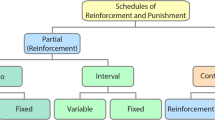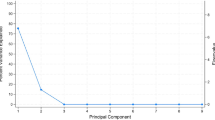Abstract
We model the climate negotiations and the countries’ individual commitments to carbon dioxide reductions as a threshold public goods game with uncertain threshold value. We find that a non-binding unanimous voting procedure on contribution vectors leads to frequent agreement on an optimal total contribution and high rates of compliance, even in the case of heterogeneous marginal contribution costs. However, groups that do not reach agreement perform worse than the baseline treatments without a voting procedure. The contribution vectors chosen by the groups point to a predominant burden-sharing rule that equalizes individual contribution costs, even at the cost of the group’s total payoff.



Similar content being viewed by others
Notes
https://unfccc.int/resource/docs/2015/cop21/eng/l09r01.pdf, last accessed March 27, 2016.
E.g., in the 2009 Copenhagen Accord, http://unfccc.int/resource/docs/2009/cop15/eng/11a01.pdf, last accessed March 27, 2016.
E.g., Hansen et al. (2008) give a range of 350–550 ppm for an atmospheric concentration of \(\hbox {CO}_2\) which could result in sudden damages.
Compare also a recent survey of theoretical models of climate change cooperation by Hovi et al. (2015) which however assumes a “non-lumpy” linear public goods game.
http://unfccc.int/resource/docs/convkp/kpeng.pdf, last accessed March 27, 2016.
See UNEP (2015) for a similar ranking of future emissions.
Using the median damage estimate of 135 \({US\$}/{tCO_2}\) by Tol (2013).
For example, in Gallier et al. (2016) the theoretical solution of several treatments results in all players investing their entire endowment, yielding a specific proportion of contributions for rich and poor players.
The treatment names are a combination of the decision rules (i.e., NBV for the non-binding vote, RG for the baseline repeated game) and the existence of heterogeneity (HOM or HET). The instructions to all treatments are available as an electronic supplement.
Feige (2016) instead assumes that the contribution costs are refunded in this case.
In order to make sure that all groups in all treatments face the same sequence of threshold values, the actual random draw occurs before the experiments by determining the threshold value for each of the ten rounds through a coin toss.
In two additional treatments, the vote was split into two stages: first a vote on the total contribution, then a vote on the allocation of this total contribution among the group members. As these treatments did not generate any additional insights, however, the results are not reported here. See also Feige (2016, Chapter 6), which describes another experimental series with a binding vote conducted for an earlier version of this paper.
For more details see Feige (2016, Chapter 1, Section 1.1.4, and Chapter 5, Section 5.2.2).
Any other contribution vector (with the exception of zero contributions) requires an equilibrium path that prescribes different actions in at least two rounds (as the final round must always end in a stage-game equilibrium). We ignore these vectors in the following, as they require complex equilibrium strategies which we do not consider relevant for tacit coordination.
In all treatments the sequence of threshold values in CU is 16, 12, 16, 12, 12, 12, 12, 12, 16, 12. The long sequence of low thresholds (Round 4–8) may be the cause of a significant increase of average total contributions from Round 9 (14.74 CU) to Round 10 (15.44 CU). Wilcoxon signed-rank test, all groups combined: \(z = 2.7\), \(p = 0.007\).
Two-tailed Mann-Whitney-U-test applied to the absolute frequency of 4 CU contribution in each group: RGHOM versus RGHET—\(z = 3.532, p = 0.00042\); average absolute frequencies: 26.78 of 40 (RGHOM) and 2.22 of 40 (RGHET). NBVHOM versus NBVHET—\(z = 3.18, p = 0.0015\); average absolute frequencies: 34.71 of 40 (NBVHOM) and 0.25 of 40 (NBVHET).
NBVHOM: 46 of 70 or 65.7%, NBVHET: 51 of 80 or 63.8%.
Two RGHET groups coordinate on (2, 2, 5, 7), for example.
Frequent examples include (3, 4, 4, 4) for homogeneous groups.
In fact, Feige (2016, Chapter 4) describes a treatment with a similar parameterization and heterogeneous endowments, but certain threshold value, which corroborates this expectation.
NBVHOM: 97.3% comply, 0.5% contribute too much, 2.2% too little; NBVHET: 99.5% comply, 0.5% contribute too little.
References
Ackerman F, Stanton EA, Bueno R (2013) CRED: a new model of climate and development. Ecol Econ 85:166–176. doi:10.1016/j.ecolecon.2011.04.006
Alberti F, Cartwright EJ (2016) Full agreement and the provision of threshold public goods. Public Choice 166:205–233. doi:10.1007/s11127-016-0321-z
Bagnoli M, Lipman BL (1989) Provision of public goods: Fully implementing the core through private contributions. Rev Econ Stud 56:583–601
Bagnoli M, Lipman BL (1992) Private provision of public goods can be efficient. Public Choice 74:59–78
Barrett S (1994) Self-enforcing international environmental agreements. Oxford Econ Pap 46:878–894 Special Issue on Environmental Economics
Barrett S (2013) Climate treaties and approaching catastrophes. J Environ Econ Manag 66(2):235–250. doi:10.1016/j.jeem.2012.12.004
Barrett S, Dannenberg A (2012) Climate negotiations under scientific uncertainty. PNAS 109(43):17,372–17,376. doi:10.1073/pnas.1208417109
Barrett S, Dannenberg A (2014) Sensitivity of collective action to uncertainty about climate tipping points. Nat Clim Chang 4:36–39. doi:10.1038/NCLIMATE2059
Benoit JP, Krishna V (1993) Renegotiation in finitely repeated games. Econometrica 61(2):303–323
Brekke KA, Konow J, Nyborg K (2012) Cooperation is relative: income and framing effects with public goods. http://www.sv.uio.no/econ/english/research/unpublished-works/working-papers/pdf-files/2012/Memo-16-2012.pdf. Memorandum No. 16/2012. Department of Economics, University of Oslo
Burton-Chellew MN, May RM, West SA (2013) Combined inequality in wealth and risk leads to disaster in the climate change game. Climatic Change 120:815–830. doi:10.1007/s10584-013-0856-7
Carraro C, Siniscalco D (1993) Strategies for the international protection of the environment. J Public Econ 52:309–328
Chander P, Tulkens H (1995) A core-theoretic solution for the design of cooperative agreements on transfrontier pollution. Int Tax Public Finan 2:279–293
Cherry TL, McEvoy DM (2013) Enforcing compliance with environmental agreements in the absence of strong institutions: An experimental analysis. Environ Resour Econ 54:63–77. doi:10.1007/s10640-012-9581-3
Croson R, Marks M (2000) Step returns in threshold public goods: a meta- and experimental analysis. Exp Econ 2:239–259
Croson R, Marks M (2001) The effect of recommended contributions in the voluntary provision of public goods. Econ Inq 39(2):238–249
Dannenberg A, Löschel A, Paolacci G, Reif C, Tavoni A (2015) On the provision of public goods with probabilistic and ambiguous thresholds. Environ Resour Econ 61:365–383. doi:10.1007/s10640-014-9796-6
Engström G, Gars J (2016) Climatic tipping points and optimal fossil-fuel use. Environ Resour Econ 65(3):541–571. doi:10.1007/s10640-016-0042-2
Farrell J (1993) Meaning and credibility in cheap-talk games. Game Econ Behav 5:514–531
Feige C (2016) Voting and equilibrium selection in threshold public goods games. PhD thesis, Karlsruhe Institute of Technology (KIT). doi:10.5445/IR/1000062003
Finus M (2001) Game theory and international environmental cooperation. Edward Elgar Publishing, Cheltenham, Northampton, New Horizons in Environmental Economics
Fischbacher U (2007) z-Tree: Zurich toolbox for ready-made economic experiments. Exp Econ 10(2):171–178. doi:10.1007/s10683-006-9159-4
Gallier C, Kesternich M, Sturm B (2016) Voting for burden sharing rules in public goods games. Environ Resour Econ. doi:10.1007/s10640-016-0022-6
Greiner B (2015) Subject pool recruitment procedures: organizing experiments with ORSEE. J Econ Sci Assoc 1:114–125. doi:10.1007/s40881-015-0004-4
Hansen J, Sato M, Kharecha P, Beerling D, Berner R, Masson-Delmotte V, Pagani M, Raymo M, Royer DL, Zachos JC (2008) Target atmospheric CO2: Where should humanity aim? Open Atmos Sci J 2:217–231
Heuson C, Peters W, Schwarze R, Topp AK (2015) Investment and adaptation as commitment devices in climate politics. Environ Resour Econ 62(4):769–790. doi:10.1007/s10640-015-9887-z
Hovi J, Ward H, Grundig F (2015) Hope or despair? Formals models of climate cooperation. Environ Resour Econ 62(4):665–688. doi:10.1007/s10640-014-9799-3
IPCC (2014) Climate change 2014: synthesis report. Contribution of working groups I, II and III to the fifth assessment report of the intergovernmental panel on climate change. IPCC, Geneva, Switzerland
Iris D, Lee J, Tavoni A (2016) Delegation and public pressure in a threshold public goods game: theory and experimental evidence. https://papers.ssrn.com/sol3/papers.cfm?abstract_id=2752895, FEEM working paper no. 26.2016
Isaac RM, Schmidtz D, Walker JM (1989) The assurance problem in a laboratory market. Public Choice 62(3):217–236
Kroll S, Cherry TL, Shogren JF (2007) Voting, punishment, and public goods. Econ Inq 45(3):557–570. doi:10.1111/j.1465-7295.2007.00028.x
Li B, Gasser T, Ciais P, Piao S, Tao S, Balkanski Y, Hauglustaine D, Boisier JP, Chen Z, Huang M, Li LZ, Li Y, Liu H, Liu J, Peng S, Shen Z, Sun Z, Wang R, Wang T, Yin G, Yin Y, Zeng H, Zeng Z, Zhou F (2016) The contribution of China’s emissions to global climate forcing. Nature 531:357–361. doi:10.1038/nature17165
McBride M (2010) Threshold uncertainty in discrete public good games: an experimental study. Econ Gov 11:77–99. doi:10.1007/s10101-009-0069-8
Milinski M, Sommerfeld RD, Krambeck HJ, Reed FA, Marotzke J (2008) The collective-risk social dilemma and the prevention of simulated dangerous climate change. PNAS 105(7):2291–2294. doi:10.1073/pnas.0709546105
Milinski M, Röhl T, Marotzke J (2011) Cooperative interaction of rich and poor can be catalyzed by intermediate climate targets. Climatic Change 109:807–814. doi:10.1007/s10584-011-0319-y
Moulin H (1988) Axioms of cooperative decision making. Econometric Society Monographs No. 15, Cambridge University Press, Cambridge
Olivier JGJ, Janssens-Maenhout G, Muntean M, Peters JHAW (2015) Trends in global CO2 emissions—2015 report. Tech. rep., PBL Netherlands Environmental Assessment Agency, JRC report 98184/PBL report 1803
Rapoport A, Suleiman R (1993) Incremental contribution in step-level public goods games with asymmetric players. Organ Behav Hum Dec 55:171–194
Schelling TC (1980) The strategy of conflict. Harvard University Press, Cambridge
Suleiman R, Budescu DV, Rapoport A (2001) Provision of step-level public goods with uncertain provision threshold and continuous contribution. Group Decis Negot 10:253–274
Tavoni A, Dannenberg A, Kallis G, Löschel A (2011) Inequality, communication, and the avoidance of disastrous climate change in a public goods game. PNAS 108(29):11,825–11,829. doi:10.1073/pnas.1102493108
Tol RSJ (2013) Targets for global climate policy: an overview. J Econ Dyn Control 37:911–928. doi:10.1016/j.jedc.2013.01.001
UNEP (2015) The emissions gap report 2015. Tech. rep, United Nations Environment Program (UNEP), Nairobi
Waichman I, Requate T, Karde M, Milinski M (2014) Asymmetry enhances success chances for international climate change negotiations. http://www.webmeets.com/files/papers/wcere/2014/1135/Requate-WCERE-2014.pdf. Working Paper. University of Heidelberg
Walker JM, Gardner R, Herr A, Ostrom E (2000) Collective choice in the commons: experimental results on proposed allocation rules and votes. Econ J 110:212–234
Acknowledgements
We appreciate helpful comments by Timo Goeschl (the editor), Carlo Gallier, Jan Kersting, Martin Kesternich, and several anonymous reviewers, as well as the participants at the GfeW Jahrestagung 2013, the 51st Annual Meetings of the Public Choice Society, and the 2014 Spring Meeting of Young Economists. Karl-Martin Ehrhart acknowledges funding by the German Federal Ministry for Education and Research (grant number: 01LA1127B). We also thank Ann-Katrin Hanke and Nayeli Gast-Zepeda for indispensable research assistance.
Author information
Authors and Affiliations
Corresponding author
Ethics declarations
Conflicts of interest
The authors declare that they do not have any conflicts of interest.
Informed Consent
Informed consent was obtained from all individual participants included in the study.
Electronic supplementary material
Below is the link to the electronic supplementary material.
Rights and permissions
About this article
Cite this article
Feige, C., Ehrhart, KM. & Krämer, J. Climate Negotiations in the Lab: A Threshold Public Goods Game with Heterogeneous Contributions Costs and Non-binding Voting. Environ Resource Econ 70, 343–362 (2018). https://doi.org/10.1007/s10640-017-0123-x
Accepted:
Published:
Issue Date:
DOI: https://doi.org/10.1007/s10640-017-0123-x




